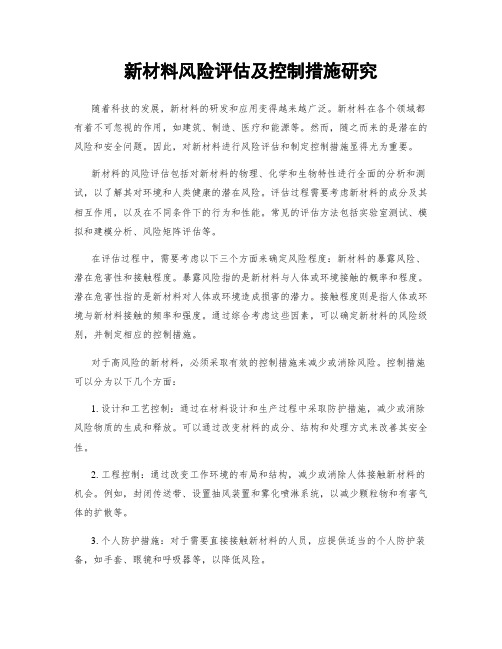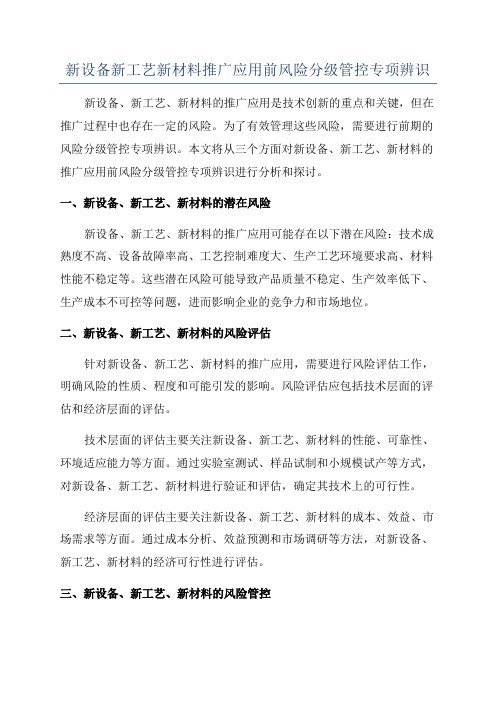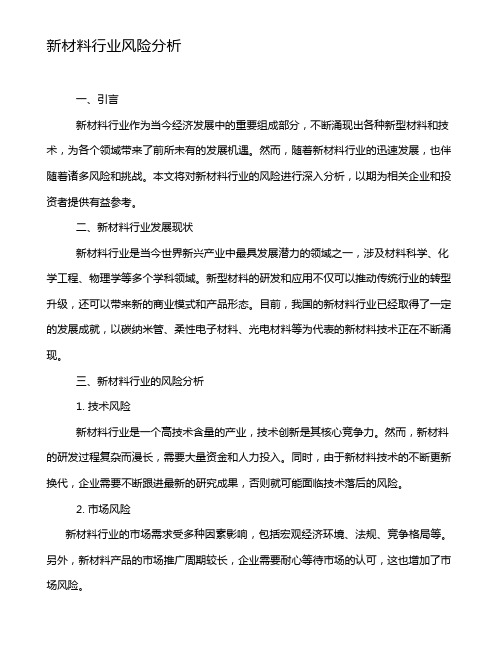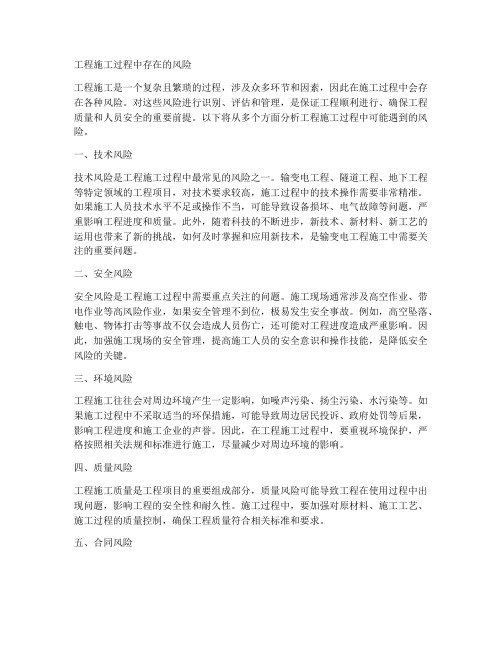新技术与新材料的环境风险
建筑设计行业风险应对

建筑设计行业风险应对在建筑设计行业中,面临各种各样的风险是不可避免的。
这些风险可能来自于项目的技术复杂性、市场竞争、法律法规的变化以及人员管理等方面。
只有通过有效的风险管理和应对措施,建筑设计企业才能确保项目的顺利进行和企业长期发展。
本文将探讨建筑设计行业常见的风险,并提出相应的应对策略。
一、技术风险1.1 设计风险在建筑设计过程中,设计师面临着各种技术挑战,包括结构设计、材料选择、建筑环境等。
设计风险的存在可能导致项目的延误、成本超支以及质量问题。
应对策略:- 加强技术人员培养,提高设计师的专业素质和技能水平;- 定期组织技术交流与培训,促进设计团队成员之间的合作与学习;- 引入先进的设计软件和技术工具,提高设计效率和准确性。
1.2 技术创新和更新风险建筑设计行业的技术更新速度较快,新的设计理念、材料和技术不断涌现。
但是,采用新技术和新材料也带来了一定的风险,可能引发问题并影响项目进展。
- 抽出时间和资源,及时了解和学习新技术和新材料,并评估其适用性和可行性;- 在应用新技术和新材料之前,进行充分的实验和试验,确保其可靠性和安全性;- 与其他行业相关方进行合作,共同推进技术创新和应用。
二、市场风险2.1 政策风险建筑设计行业的市场环境和政策法规密切相关,政策风险可能导致市场竞争力降低、项目被取消或调整等问题。
应对策略:- 关注政策法规的变化,及时了解最新政策和行业动态,做好预判和应对;- 加强与政府部门的沟通和合作,争取政策支持和项目机会;- 建立健全的风险评估机制,根据政策变化及时制定相应的应对策略。
2.2 经济周期风险建筑设计行业受经济周期波动的影响较大,经济下行周期可能导致项目减少,市场竞争加剧,企业面临盈利压力。
- 多元化业务,降低对特定项目的依赖,分散风险;- 提高企业内部的运营效率和管理水平,降低成本,提高竞争力;- 寻找新的市场机会,开拓国际市场,降低对特定地区市场的依赖。
三、法律风险3.1 知识产权风险建筑设计行业涉及到大量的知识产权问题,包括专利、著作权等。
探索新材料的潜在风险及预防措施分析

探索新材料的潜在风险及预防措施分析新材料的不断涌现为我们的科技发展带来了许多机遇和挑战。
然而,随之而来的新材料潜在风险也不容忽视。
本文将探讨新材料的潜在风险,并提出一些预防措施,以确保我们能够安全地利用这些新材料。
在探索新材料的风险之前,我们首先应该了解新材料到底是什么。
新材料是指经过特殊处理或合成的材料,具有传统材料所不具备的独特性能和性质。
它们可以应用于各个领域,如能源、医疗、电子等。
然而,新材料的独特性也意味着其潜在的风险,不可忽视。
首先,新材料可能会引发环境风险。
许多新材料在制备和应用过程中可能会产生有害物质,对环境造成污染。
例如,某些纳米材料具有高毒性,可能会对生态系统和生物多样性产生负面影响。
因此,在开发新材料时,必须充分考虑其环境可持续性,采取相应的预防措施来减少对环境的影响。
其次,新材料可能会对人类健康产生潜在风险。
一些新材料具有刺激性、致敏性甚至毒性,可能对人体造成伤害。
例如,一些纳米材料可能穿透皮肤或进入呼吸道,对人体造成慢性毒性。
因此,在新材料的开发和应用过程中,需要进行充分的风险评估和安全监测,确保其不会对人类健康造成威胁。
此外,新材料的应用也可能引起技术性风险。
由于新材料的性质和应用方式与传统材料有所不同,我们对其性能、稳定性和可靠性了解的可能不够充分。
因此,在使用新材料时,我们需要考虑其长期稳定性和可靠性,并采取相应的预防措施来减少潜在的技术风险。
为了减少新材料的潜在风险,我们可以采取以下预防措施。
首先,建立全面的风险评估体系,对新材料进行全面的评估和监测。
这包括对新材料在制备过程中产生的有害物质进行评估,对新材料的毒性和致敏性进行测试,以及对其环境和健康风险进行评估等。
通过建立完善的风险评估体系,我们可以及早发现潜在的风险,并采取相应的措施来降低风险。
其次,加强新材料的监管和管理。
政府、科研机构和企业应共同努力,建立健全的新材料监管和管理体制,制定相关的法规和标准,规范新材料的研发、生产和应用过程。
新设备新材料新工艺评估办法

新设备新材料新工艺评估办法背景随着科技的不断发展,新的设备、新的材料、新的工艺不断涌现出来。
这些新技术的引入,可以极大地推进相关领域的发展,提高产业的效益。
但是,在引入新技术之前,必须进行全面的评估,以确保新技术能够真正地满足现有需求,并且不会带来不良影响。
评估流程环境评估新技术引入可能会对环境造成影响,因此,必须进行环境评估。
环境评估是一个综合性的过程,它包括四个方面的评估:1.生态环境评估–调查新技术可能对生物多样性、生态系统、水资源、土地资源等生态环境带来的影响,预测并评估这些影响的潜在大小和严重性;–针对可能存在的影响提出相应的环境保护措施,以降低影响的风险。
2.气候变化评估–调查新技术引入可能导致的温度、降水等气象要素的变化,以及可能造成的自然灾害;–针对可能存在的影响提出相应的应对措施,以减轻灾害风险。
3.社会影响评估–调查新技术引入可能对社会资源、社会经济开发、居民健康等方面的影响,预测并评估这些影响的潜在大小和严重性;–针对可能存在的影响提出相应的社会保障措施,以保证社会稳定。
4.人类健康评估–调查新技术可能对人类健康的潜在危害,例如新材料可能带来的有害物质等,预测并评估这些危害的潜在大小和严重性;–针对可能存在的危害提出相应的风险控制措施,以降低危害的风险。
技术评估新技术的推广需要通过技术评估来了解其性能、可行性、可靠性等。
1.性能评估–评估新技术的实际操作能力与设计能力的一致程度;–评估新技术的相关性能指标,如速度、精度等。
2.可行性评估–评估新技术与已有技术的兼容性;–评估新技术实施的难易程度,以及实施新技术所需的人力、设备等资源。
3.可靠性评估–评估新技术的可靠性和稳定性;–评估新技术的故障率和维护需求。
成本评估新技术的引入还必须进行成本评估,包括硬件成本、软件成本、培训成本、运营成本、维护成本等。
1.硬件成本评估–评估新技术所需的硬件设备、软件系统的采购成本;–初投资及后期更新的成本评估。
市政建筑工程对新技术新工艺新材料的运用及对策

市政建筑工程对新技术新工艺新材料的运用及对策引言随着科技的不断发展,新技术、新工艺和新材料在市政建筑工程中的运用得到了广泛的关注。
这些新技术、新工艺和新材料不仅可以提高市政建筑工程的质量和效率,还能够满足人们对环保、节能和可持续发展的需求。
然而,市政建筑工程对新技术、新工艺和新材料的运用也存在一些挑战和风险。
本文将探讨市政建筑工程对新技术、新工艺和新材料的运用,并提出相应的对策。
新技术的运用新技术在市政建筑工程中的运用主要体现在工程设计、施工和监控等方面。
其中,BIM技术、无人机技术、虚拟现实技术等都可以提高工程设计的精度和效率。
例如,利用BIM技术可以实现工程设计和模拟施工过程,减少设计和施工中的错误和风险。
此外,无人机技术可以用于对工程施工现场的监控和勘测,提高工程施工的安全性和准确性。
虚拟现实技术可以帮助工程师和施工人员更直观地理解工程设计和施工要求。
然而,新技术的运用也存在一些挑战。
首先,新技术的引入需要投入大量的资金和培训成本。
其次,新技术的不断更新和发展可能导致老旧设备的淘汰和更新,给企业带来经济负担。
另外,新技术的运用还需要考虑隐私和安全等问题。
针对这些挑战和问题,我们可以采取以下对策:1. 提前规划和预算:在引入新技术前,进行充分的规划和预算,包括资金、培训和设备更新等方面。
2. 持续研究和研发:要跟踪新技术的发展动态,进行持续研究和研发,以保持技术的领先优势。
3. 加强安全管理:在运用新技术时,要注重隐私和安全等方面的管理,保护相关信息的安全性。
新工艺的运用新工艺在市政建筑工程中的运用主要涉及施工工艺和管理工艺等方面。
新工艺可以提高施工效率和工程质量,减少施工风险和资源浪费。
例如,预制装配式建筑(也称为模块化建筑)可以在工厂中进行加工和生产,然后在现场进行简单的组装,提高了施工的速度和质量,并减少了对现场资源的消耗。
然而,新工艺的运用也会面临一些难题。
首先,新工艺可能需要使用全新的设备和材料,导致相关设备和材料的供应问题。
新材料行业风险分析

新材料行业风险分析摘要:本报告旨在对新材料行业的风险进行全面的分析。
首先,我们将介绍新材料行业的背景和发展现状。
然后,我们将详细分析新材料行业的主要风险因素,包括技术风险、市场风险、风险和环境风险。
最后,我们将提出相应的风险管理对策,以帮助新材料行业应对风险并实现可持续发展。
1. 引言1.1 研究背景1.2 研究目的和意义2. 新材料行业的背景和发展现状2.1 定义和分类2.2 新材料行业的重要性2.3 新材料行业的发展趋势3. 技术风险分析3.1 技术创新的不确定性3.2 技术验证和验证的困难3.3 技术应用的不确定性3.4 技术转化和产业化风险4. 市场风险分析4.1 市场需求和供应的不确定性4.2 市场竞争的风险4.3 供应链的不稳定性5. 风险分析5.1 领导的不确定性5.2 领导的变化5.3 领导支持和补贴的风险6. 环境风险分析6.1 环境法规和标准的不确定性6.2 环境责任和安全风险6.3 资源限制和可持续性风险7. 新材料行业风险管理对策7.1 技术风险管理对策7.2 市场风险管理对策7.3 风险管理对策7.4 环境风险管理对策8. 结论8.1 主要研究结果的总结8.2 对新材料行业风险管理的建议Abstract:This report aims to provide a comprehensive analysis of the risks in the new materials industry. Firstly, we will introduce the background and current development of the new materials industry. Then, we will analyze in detail the main risk factors in the industry, including technological risks, market risks, policy risks, and environmental risks. Finally, we will propose corresponding risk management strategies to help the new materials industry cope with risks and achieve sustainable development.1. Introduction1.1 Research background1.2 Research purpose and significance2. Background and current development of the new materials industry2.1 Definition and classification2.2 Importance of the new materials industry2.3 Trends in the development of the new materials industry3. Analysis of technological risks3.1 Uncertainties in technological innovation3.2 Difficulties in technology verification and validation3.3 Uncertainties in technology application3.4 Risks in technology transfer and industrialization4. Analysis of market risks4.1 Uncertainties in market demand and supply4.2 Risks of market competition4.3 Instability in the supply chain5. Analysis of policy risks5.1 Uncertainties in government policies5.2 Changes in government policies5.3 Risks of government support and subsidies6. Analysis of environmental risks6.1 Uncertainties in environmental regulations and standards6.2 Risks of environmental responsibility and safety6.3 Risks of resource limitations and sustainability7. Risk management strategies for the new materials industry7.1 Risk management strategies for technological risks7.2 Risk management strategies for market risks7.3 Risk management strategies for policy risks7.4 Risk management strategies for environmental risks8. Conclusion8.1 Summary of key research findings8.2 Recommendations for risk management in the new materials industry.。
新材料风险评估及控制措施研究

新材料风险评估及控制措施研究随着科技的发展,新材料的研发和应用变得越来越广泛。
新材料在各个领域都有着不可忽视的作用,如建筑、制造、医疗和能源等。
然而,随之而来的是潜在的风险和安全问题。
因此,对新材料进行风险评估和制定控制措施显得尤为重要。
新材料的风险评估包括对新材料的物理、化学和生物特性进行全面的分析和测试,以了解其对环境和人类健康的潜在风险。
评估过程需要考虑新材料的成分及其相互作用,以及在不同条件下的行为和性能。
常见的评估方法包括实验室测试、模拟和建模分析、风险矩阵评估等。
在评估过程中,需要考虑以下三个方面来确定风险程度:新材料的暴露风险、潜在危害性和接触程度。
暴露风险指的是新材料与人体或环境接触的概率和程度。
潜在危害性指的是新材料对人体或环境造成损害的潜力。
接触程度则是指人体或环境与新材料接触的频率和强度。
通过综合考虑这些因素,可以确定新材料的风险级别,并制定相应的控制措施。
对于高风险的新材料,必须采取有效的控制措施来减少或消除风险。
控制措施可以分为以下几个方面:1. 设计和工艺控制:通过在材料设计和生产过程中采取防护措施,减少或消除风险物质的生成和释放。
可以通过改变材料的成分、结构和处理方式来改善其安全性。
2. 工程控制:通过改变工作环境的布局和结构,减少或消除人体接触新材料的机会。
例如,封闭传送带、设置抽风装置和雾化喷淋系统,以减少颗粒物和有害气体的扩散等。
3. 个人防护措施:对于需要直接接触新材料的人员,应提供适当的个人防护装备,如手套、眼镜和呼吸器等,以降低风险。
4. 定期监测和检测:对新材料的使用环境进行定期检测和监测,以及时发现和解决潜在的风险问题。
包括空气质量监测、水质检测和工作场所噪音监测等。
除了上述控制措施,还需要加强管理和培训,确保员工具备必要的知识和技能,能够正确识别和处理新材料的风险。
管理措施包括建立风险评估和报告机制,确保风险信息的及时传递和交流。
培训措施包括提供相关的安全知识和操作技能培训,以提高员工的安全意识和能力。
新材料引发的安全隐患与应对对策

新材料引发的安全隐患与应对对策随着技术的不断进步和创新,新材料的研发和应用得到了广泛推广。
新材料为各个领域带来了巨大的便利和发展机遇,但同时也带来了一系列的安全隐患。
本文将探讨新材料引发的安全隐患,并提出相应的应对对策。
首先,新材料的引入可能会导致环境污染和生态破坏。
许多新材料的制备和应用过程中需要大量的能源和原材料,这可能会增加对环境的压力。
同时,一些新材料的废弃物可能具有毒性或其他有害物质,如果处理不当,可能会对周围的土壤和水源造成污染,危害生态系统的平衡。
因此,采取有效的环境保护措施是必要的。
政府应加强对新材料生产企业的监管,促使其遵守环保法规和标准,并加大环境监测和治理力度,确保新材料的生产和应用过程不会对环境和生态系统造成严重损害。
其次,新材料的研发和应用也可能带来安全风险。
一些新材料可能具有较高的火灾风险、爆炸风险或其他安全风险。
例如,一些高能量密度的电池材料可能在充电或工作过程中发生火灾或爆炸。
为了降低这些安全风险,对新材料的性能和使用环境进行全面评估是必要的。
同时,制定并执行相关的安全管理措施也是至关重要的。
企业应建立健全的安全制度和操作规程,加强员工的安全培训和意识教育,确保员工能够正确操作和处置新材料,避免潜在的安全事故的发生。
新材料的引入还可能对人体健康产生影响。
一些新材料可能释放有害物质,如挥发性有机化合物、重金属等,而这些物质对人体健康具有一定的危害性。
因此,在新材料的研发和应用过程中,应加强对其安全性和生物相容性的评估,避免使用对人体健康有潜在危害的材料。
此外,对从事与新材料接触的工人进行健康监测是必要的,以及时发现和处理与新材料相关的职业健康问题。
此外,新材料的引入还可能带来信息安全的隐患。
一些新材料可能应用于智能设备和物联网领域,这使得信息的传输和存储更加便捷。
然而,这也给信息安全带来了新的挑战。
为了防止信息泄漏和黑客攻击,企业和研发机构应加强对新材料关键技术的保护,加密和控制信息的传输和存储,并建立健全的信息安全管理体系。
新设备新工艺新材料推广应用前风险分级管控专项辨识

新设备新工艺新材料推广应用前风险分级管控专项辨识新设备、新工艺、新材料的推广应用是技术创新的重点和关键,但在推广过程中也存在一定的风险。
为了有效管理这些风险,需要进行前期的风险分级管控专项辨识。
本文将从三个方面对新设备、新工艺、新材料的推广应用前风险分级管控专项辨识进行分析和探讨。
一、新设备、新工艺、新材料的潜在风险新设备、新工艺、新材料的推广应用可能存在以下潜在风险:技术成熟度不高、设备故障率高、工艺控制难度大、生产工艺环境要求高、材料性能不稳定等。
这些潜在风险可能导致产品质量不稳定、生产效率低下、生产成本不可控等问题,进而影响企业的竞争力和市场地位。
二、新设备、新工艺、新材料的风险评估针对新设备、新工艺、新材料的推广应用,需要进行风险评估工作,明确风险的性质、程度和可能引发的影响。
风险评估应包括技术层面的评估和经济层面的评估。
技术层面的评估主要关注新设备、新工艺、新材料的性能、可靠性、环境适应能力等方面。
通过实验室测试、样品试制和小规模试产等方式,对新设备、新工艺、新材料进行验证和评估,确定其技术上的可行性。
经济层面的评估主要关注新设备、新工艺、新材料的成本、效益、市场需求等方面。
通过成本分析、效益预测和市场调研等方法,对新设备、新工艺、新材料的经济可行性进行评估。
三、新设备、新工艺、新材料的风险管控在新设备、新工艺、新材料的推广应用过程中,需要采取相应的风险管控措施,以降低风险对企业的影响。
首先,加强技术研究和开发,提高新设备、新工艺、新材料的技术成熟度。
通过技术攻关和引进外部专家,提升新技术的稳定性和可操作性,减少技术上的风险。
其次,建立完善的质量管理体系,严格控制生产过程中的风险点。
通过制定标准操作规程、加强监测和检测,确保产品质量的稳定性和可靠性。
再次,加强人员培训和技术交流,提高员工对新技术的理解和掌握。
通过培训和研讨会等方式,增加员工对新设备、新工艺、新材料的认识,提高其操作能力和风险意识。
施工风险类型

施工风险类型施工过程中存在各种各样的风险,这些风险可能会对工程项目的安全性、质量和进度产生影响。
了解和识别施工风险类型对于有效地管理和控制风险至关重要。
以下是一些常见的施工风险类型:1. 安全风险:施工现场的安全问题是最常见的风险之一。
这包括高处作业、电气安全、机械设备操作、化学品使用等方面的风险。
例如,高处作业可能导致坠落事故,电气设备可能引发火灾或电击事故。
2. 环境风险:施工过程中可能对环境造成负面影响,如土壤污染、水源污染、噪音和振动等。
这些风险需要通过合理的环境管理措施来减少。
3. 质量风险:质量问题可能会导致工程项目的结构不稳定或功能失效。
例如,使用低质量材料、施工过程中出现错误或疏忽等。
这些风险需要通过质量控制措施来降低。
4. 进度风险:施工项目的延误可能会导致额外的成本和资源浪费。
这些风险可能来自于施工计划的不合理安排、材料供应延迟、人力资源不足等。
5. 经济风险:施工项目的成本管理是一个重要的风险管理方面。
成本超支可能会导致项目无法按时完成或无法达到预期的质量标准。
这些风险需要通过合理的成本控制和预算管理来降低。
6. 法律风险:施工过程中需要遵守各种法律法规和标准。
违反法律法规可能会导致法律诉讼、罚款或项目停工等风险。
7. 沟通风险:施工项目涉及众多参与方,包括业主、设计师、承包商、监理等。
沟通不畅可能会导致误解、冲突和延误。
8. 技术风险:施工过程中使用的新技术或新材料可能存在未知的风险。
技术风险需要通过充分的技术评估和试验来降低。
9. 自然灾害风险:施工现场可能受到自然灾害的影响,如地震、洪水、风暴等。
这些风险需要通过合理的风险评估和防护措施来减少损失。
10. 人力资源风险:施工项目需要合适的人力资源来保证工程的顺利进行。
人力资源风险包括人员技能不足、工人流失、劳动力成本上升等。
以上是一些常见的施工风险类型,不同的项目可能存在不同的风险。
在施工项目中,及时识别和评估这些风险,并采取相应的控制和管理措施,可以有效地降低施工风险对项目的影响。
新材料行业风险分析

新材料行业风险分析一、引言新材料行业作为当今经济发展中的重要组成部分,不断涌现出各种新型材料和技术,为各个领域带来了前所未有的发展机遇。
然而,随着新材料行业的迅速发展,也伴随着诸多风险和挑战。
本文将对新材料行业的风险进行深入分析,以期为相关企业和投资者提供有益参考。
二、新材料行业发展现状新材料行业是当今世界新兴产业中最具发展潜力的领域之一,涉及材料科学、化学工程、物理学等多个学科领域。
新型材料的研发和应用不仅可以推动传统行业的转型升级,还可以带来新的商业模式和产品形态。
目前,我国的新材料行业已经取得了一定的发展成就,以碳纳米管、柔性电子材料、光电材料等为代表的新材料技术正在不断涌现。
三、新材料行业的风险分析1. 技术风险新材料行业是一个高技术含量的产业,技术创新是其核心竞争力。
然而,新材料的研发过程复杂而漫长,需要大量资金和人力投入。
同时,由于新材料技术的不断更新换代,企业需要不断跟进最新的研究成果,否则就可能面临技术落后的风险。
2. 市场风险新材料行业的市场需求受多种因素影响,包括宏观经济环境、法规、竞争格局等。
另外,新材料产品的市场推广周期较长,企业需要耐心等待市场的认可,这也增加了市场风险。
3. 资金风险新材料行业的研发投入较高,尤其是在初创阶段,企业往往需要大量资金用于技术研发和市场推广。
如果企业的资金链出现问题,就可能导致项目无法继续推进,甚至倒闭。
4. 风险新材料行业受国家法规的影响较大,的不确定性和变化性都可能对企业的经营产生不利影响。
尤其是在环保、安全等方面,领导对新材料行业的监管力度越来越大,企业需要不断适应变化,否则就会面临风险。
5. 竞争风险新材料行业的竞争十分激烈,企业之间不仅要面对同行业内的竞争对手,还要面对来自传统材料行业和跨界产业的竞争。
企业如果不能保持自身的核心竞争力,就很容易被市场淘汰。
四、新材料行业风险管理对策1. 加强技术创新,提升竞争力企业要不断加大对技术研发的投入,与时俱进地引入新技术、新材料,提升产品的品质和性能。
技术创新与环境保护的互促关系分析

技术创新与环境保护的互促关系分析近年来,随着科技的不断进步和全球环境问题的日益突出,技术创新与环境保护之间的互促关系备受关注。
本文将从多个角度探讨技术创新与环境保护之间的相互作用,并分析其对人类社会的重要意义。
首先,技术创新为环境保护提供了重要的手段和工具。
随着科技的发展,各种高效、低耗的环保技术不断涌现,如清洁能源、节能减排技术、废物处理技术等。
这些技术的应用,可以显著减少资源的消耗和环境的污染,为实现可持续发展提供了强有力的支持。
例如,太阳能和风能等清洁能源的利用,可以减少对传统化石燃料的依赖,降低温室气体的排放,从而减缓全球气候变化的速度。
同时,节能减排技术的应用,可以降低工业生产和生活消费中的能源消耗,减少对环境的负面影响。
因此,技术创新在环境保护中的作用不可忽视。
其次,环境保护也对技术创新提出了更高的要求。
随着环境问题的日益严重,人们对技术的环保性能和可持续性提出了更高的期望。
环境保护的需求推动了科技研发的方向和重点,促使科学家和工程师们寻找更加环保的解决方案。
例如,在汽车工业中,由于传统燃油汽车对空气质量和气候变化造成的影响日益明显,电动汽车等新能源汽车的研发和推广成为了行业的重要方向。
这种环境需求驱动的技术创新,不仅可以改善环境质量,还可以提升产业竞争力和经济效益。
此外,技术创新和环境保护之间还存在着相互促进的关系。
一方面,技术创新为环境保护提供了新的契机和动力。
科技的突破和创新,可以开辟新的环保领域,提供新的解决方案。
例如,近年来兴起的人工智能技术在环境监测和资源管理方面的应用,为环境保护带来了新的机遇和挑战。
另一方面,环境保护也为技术创新提供了广阔的市场和需求。
环境问题的日益严重,推动了环保产业的快速发展,为技术创新提供了更多的投资和支持。
这种相互促进的关系,为技术创新和环境保护的协同发展提供了良好的基础。
然而,技术创新与环境保护之间的互促关系也面临一些挑战和难题。
一方面,技术创新的过程中可能会带来一定的环境风险和副作用。
生态环境保护面临哪些新挑战

生态环境保护面临哪些新挑战在当今时代,生态环境保护已经成为全球范围内的重要议题。
随着人类社会的不断发展和科技的飞速进步,生态环境保护面临着一系列新的挑战。
这些挑战不仅影响着我们的生活质量,更关乎着地球的未来和人类的可持续发展。
首先,快速的城市化进程给生态环境带来了巨大压力。
城市的扩张意味着更多的土地被占用,自然生态系统遭到破坏。
高楼大厦、道路桥梁的建设使得原本的绿地、湿地和森林逐渐消失,生物多样性受到威胁。
而且,城市人口的急剧增加导致了能源需求的飙升和资源的过度消耗。
大量的能源消耗主要依赖于化石燃料,这进一步加剧了温室气体的排放,引发了全球气候变暖等一系列环境问题。
其次,新技术和新材料的应用也带来了新的环境风险。
比如,纳米技术在许多领域展现出了巨大的潜力,但纳米材料的安全性和环境影响尚未完全明晰。
一些纳米颗粒可能具有毒性,进入环境后可能对生态系统和人类健康造成潜在危害。
再比如,电子垃圾的快速增长成为了一个严峻的问题。
随着电子产品更新换代速度的加快,废弃的电子产品中包含的有害物质如铅、汞、镉等,如果处理不当,会对土壤、水源和空气造成严重污染。
另外,全球气候变化是当前生态环境保护面临的最大挑战之一。
气温升高导致冰川融化、海平面上升,沿海地区面临着被淹没的危险。
极端天气事件如暴雨、干旱、飓风等的频率和强度不断增加,给农业生产、水资源管理和生态系统稳定带来了极大的不确定性。
气候变化还会影响物种的分布和生存,一些物种可能因为无法适应环境变化而灭绝,进一步破坏生态平衡。
农业现代化的发展在提高粮食产量的同时,也带来了一些环境问题。
大规模的农业生产中过度使用化肥和农药,不仅造成土壤污染和水质恶化,还会通过食物链影响人类健康。
此外,畜牧业的发展产生了大量的温室气体排放,尤其是甲烷,对气候变化产生了不可忽视的影响。
经济全球化使得环境问题更加复杂和难以解决。
国际贸易的增长促使资源在全球范围内流动,一些发展中国家为了追求经济增长,承接了来自发达国家的高污染、高能耗产业转移,导致当地生态环境恶化。
新材料行业风险分析

新材料行业风险分析第一章:引言1.1 研究背景和目的1.2 研究方法和数据来源第二章:新材料行业概述2.1新材料的定义和分类2.2 全球新材料市场概况2.3 我国新材料行业现状和发展趋势第三章:新材料行业的主要风险3.1 技术风险3.1.1 新材料研发的不确定性和复杂性3.1.2 技术转化和商业化的挑战3.2 市场需求风险3.2.1 国内外市场需求波动3.2.2 市场竞争和价格压力3.3 风险3.3.1 法规的变化和调整3.3.2 领导支持力度的不确定性3.4 供应链风险3.4.1 材料供应的稳定性和可靠性3.4.2 成本和产能的控制3.5 环境风险3.5.1 环境污染问题和资源浪费3.5.2 碳排放和能源消耗第四章:新材料行业风险管理4.1 风险识别和评估4.1.1 风险因素的分析和评估4.1.2 风险事件的发生概率和影响程度评估4.2 风险控制和规避4.2.1 技术创新和研发能力的提升4.2.2 多元化市场布局和渠道拓展4.2.3 领导关系维护和适应能力提高4.2.4 建立稳定的供应链体系和合作伙伴关系4.2.5 环境保护和可持续发展4.3 风险应对和应急预案4.3.1 风险管理和控制机制建立4.3.2 风险应对策略和行动计划制定4.3.3 应急预案和危机管理第五章:新材料行业风险案例分析5.1 技术风险案例分析5.1.1 技术研发失败案例5.1.2 技术转化难题案例5.2 市场需求风险案例分析5.2.1 市场需求波动案例5.2.2 市场竞争压力案例5.3 风险案例分析5.3.1 法规变化案例5.3.2 领导支持力度不确定案例5.4 供应链风险案例分析5.4.1 材料供应不稳定案例5.4.2 成本和产能控制失败案例5.5 环境风险案例分析5.5.1 环境污染问题案例5.5.2 碳排放和能源消耗案例第六章:风险管理的建议和措施6.1 提升技术创新和研发能力6.2 多元化市场布局和渠道拓展6.3 领导关系维护和适应能力提高6.4 建立稳定的供应链体系和合作伙伴关系6.5 加强环境保护和可持续发展意识第七章:结论以上是一份关于的课题报告,通过对新材料行业的概述、主要风险因素的分析以及风险管理的建议和措施,提供了对新材料行业的风险认识和风险管理的指导。
环保新材料与技术革新

环保新材料与技术革新随着人们对环境保护的关注度越来越高,环保行业的发展也变得越来越重要。
而新材料的发展和技术革新则成为推动环保行业进步的重要力量。
本文将探讨环保新材料和技术在环保领域的应用和发展,以及其对环境保护的积极作用。
一、环保新材料的应用环保新材料是指相对于传统材料来说,具有更良好的环保性能和应用性能的新型材料。
在环保行业中,应用广泛的环保新材料主要包括生物降解材料和可再生材料等。
1. 生物降解材料生物降解材料是指一种具有可降解性能的材料。
它能够返回大自然,并在自然条件下被分解成水和二氧化碳等无害物质。
与传统的合成材料相比,生物降解材料具有很低的环境风险,同时可以有效降低环境负担。
在实际应用中,生物降解材料可以应用于包装、餐具、纸张等多个领域。
例如,生物降解塑料通常被用来代替传统的塑料袋,这样可以减少这些塑料袋对环境带来的危害。
2. 可再生材料可再生材料是指那些可以通过自然循环过程不断再生的材料。
这些材料可以通过生物质和其他可再生资源的回收利用来提供原材料。
与传统的石化产品相比,可再生材料的生产过程具有更低的环境影响,并且可以有效地降低温室气体的排放量。
在实际应用中,目前可再生材料的主要应用领域是建筑、家居、运动休闲等。
二、环保技术的应用除了环保新材料外,环保技术的应用也成为推动环保行业发展的重要力量。
包括清洁生产技术、节能减排技术、新能源技术等等。
1. 清洁生产技术清洁生产技术是指应用现代科学和技术手段,改变传统生产方式,实现无污染、高效能的生产过程。
这样不仅可以保障生产效益,还可以降低环境污染和资源浪费,实现可持续发展。
在目前环保行业中,清洁生产技术的应用越来越广泛。
例如,在有机废气的处理中,可以采用化学吸附、生物过滤、热解和催化氧化等方法进行处理,这样可以有效地减少有机物质的排放。
2. 节能减排技术节能减排技术是指应用现代科技手段,从改良生产工序和流程、改进设备技术和提高能源利用率等方面来实现减少能源消耗和排放物的技术。
工程施工过程存在的风险

工程施工过程中存在的风险工程施工是一个复杂且繁琐的过程,涉及众多环节和因素,因此在施工过程中会存在各种风险。
对这些风险进行识别、评估和管理,是保证工程顺利进行、确保工程质量和人员安全的重要前提。
以下将从多个方面分析工程施工过程中可能遇到的风险。
一、技术风险技术风险是工程施工过程中最常见的风险之一。
输变电工程、隧道工程、地下工程等特定领域的工程项目,对技术要求较高,施工过程中的技术操作需要非常精准。
如果施工人员技术水平不足或操作不当,可能导致设备损坏、电气故障等问题,严重影响工程进度和质量。
此外,随着科技的不断进步,新技术、新材料、新工艺的运用也带来了新的挑战,如何及时掌握和应用新技术,是输变电工程施工中需要关注的重要问题。
二、安全风险安全风险是工程施工过程中需要重点关注的问题。
施工现场通常涉及高空作业、带电作业等高风险作业,如果安全管理不到位,极易发生安全事故。
例如,高空坠落、触电、物体打击等事故不仅会造成人员伤亡,还可能对工程进度造成严重影响。
因此,加强施工现场的安全管理,提高施工人员的安全意识和操作技能,是降低安全风险的关键。
三、环境风险工程施工往往会对周边环境产生一定影响,如噪声污染、扬尘污染、水污染等。
如果施工过程中不采取适当的环保措施,可能导致周边居民投诉、政府处罚等后果,影响工程进度和施工企业的声誉。
因此,在工程施工过程中,要重视环境保护,严格按照相关法规和标准进行施工,尽量减少对周边环境的影响。
四、质量风险工程施工质量是工程项目的重要组成部分,质量风险可能导致工程在使用过程中出现问题,影响工程的安全性和耐久性。
施工过程中,要加强对原材料、施工工艺、施工过程的质量控制,确保工程质量符合相关标准和要求。
五、合同风险合同风险主要涉及工程合同的签订、履行和变更等方面。
合同条款不明确、合同管理不规范等问题,可能导致合同纠纷、工程款拖欠等风险。
因此,在工程施工过程中,要重视合同管理,明确合同条款,规范合同履行,防范合同风险。
汽车零部件行业风险分析

汽车零部件行业风险分析
汽车零部件行业目前面临的主要风险有以下几个方面:
1.市场风险:汽车零部件市场竞争激烈,新材料和新技术的应用不断涌现,原材料价格波动、市场需求等因素导致市场风险较高。
2.技术创新风险:汽车零部件行业关注技术创新和研发,面临技术更新换代的风险。
如果企业不能及时掌握行业新技术和应对技术进步,就会失去竞争优势。
3.政策风险:政策调整将直接影响汽车零部件的价格、结构和质量。
政策的变化和整治行动对企业经营和发展将带来很大不确定性。
例如,中国政府推动新能源汽车发展,对于传统燃油汽车零部件市场将带来影响。
4.环境风险:汽车环保标准不断提高,对企业来说,应对污染排放、废弃物处理和资源利用等方面的压力越来越大。
企业需要根据环保法规做好治理和提升绿色制造能力。
5.品牌风险:汽车零部件是名副其实的“配角”,往往需与整车品牌有效关联以提高产品溢价与销量。
名誉受损、业务伙伴倒闭等风险随时存在,企业必须树立良好的品牌形象。
面对这些风险,汽车零部件企业要加强技术研发、降低成本、提升健康安全等工作,提高业务透明度、降低法律风险,这样才能保证企业持续发展。
新材料的环境风险评估与控制

新材料的环境风险评估与控制随着科技的进步和社会的发展,新材料的研发和应用在各个领域都取得了重大突破。
然而,新材料的广泛应用也引发了环境风险的关注。
为了保护环境和人民的健康,必须进行新材料的环境风险评估与控制。
新材料的环境风险评估是指对新材料在生产、使用和废弃过程中可能对环境产生的潜在危害进行全面评估的过程。
评估的目的是确定新材料可能引发的环境问题,了解其潜在风险并采取相应的控制措施。
评估的内容包括新材料的物理化学性质、毒性、生物降解性、生物富集性等因素。
通过对这些因素的评估,可以预测新材料在环境中的行为和效应,为环境保护和安全生产提供科学依据。
首先,新材料的环境风险评估需要考虑其物理化学性质。
物理化学性质对新材料在环境中的迁移、转化和稳定性具有重要影响。
例如,新材料的密度、挥发性和分解温度等参数会影响其在大气、水体和土壤中的分布和耐久性。
评估过程中需要详细考察这些性质,进一步判断新材料是否具有潜在环境风险。
除了物理化学性质外,新材料的毒性也是环境风险评估的重要内容。
毒性评估包括急性毒性和慢性毒性两个方面。
急性毒性是指新材料对某些生物的短时间接触导致的明显危害,而慢性毒性则是指新材料长期暴露对生物产生的潜在危害。
评估过程中需要进行毒性试验和毒性实验室研究,以获得相关数据并确定风险等级。
此外,新材料的生物降解性和生物富集性也是环境风险评估的重要内容。
生物降解性是指新材料在自然环境中被生物降解的能力,而生物富集性则是指新材料在生物体内积累的程度。
评估过程中需要考察新材料的降解速度和生物富集因子,并结合环境中的生物种群和食物链结构,综合评估新材料的生态风险。
为了控制新材料的环境风险,必须采取相应的措施。
首先是采取预防措施,包括改进生产工艺、采用环保材料和减少废弃物的排放等。
其次是加强监测和监管,建立健全的环境风险评估和监测体系,及时发现和处理新材料可能存在的环境问题。
此外,还需要加强对新材料的安全性和环境友好性的研究,鼓励和支持绿色材料的开发和应用。
新材料引发的安全风险及应对措施分析

新材料引发的安全风险及应对措施分析随着科技的不断发展,新材料的应用越来越广泛。
从高性能合金到先进的聚合物材料,新材料的出现为各行各业带来了巨大的机遇与挑战。
然而,与新材料的广泛应用同时而来的是一系列与安全相关的风险。
本文将探讨新材料引发的安全风险,并提出相应的应对措施。
首先,新材料的引入可能会导致化学物质的释放和排放,从而对环境和人类健康构成威胁。
许多新材料在制造和使用过程中会释放出有害物质,例如挥发性有机物和重金属,这些物质可能污染土壤、水源和空气。
另外,一些新材料可能对人体产生毒性影响,如致癌物质和神经毒素。
因此,必须采取适当的措施,限制和控制这些有害物质的释放和排放。
例如,严格监测和控制新材料生产过程中的化学物质使用,以及在使用新材料时采取合适的防护措施,如安全设备和个人防护用品。
其次,新材料的物理特性可能导致潜在的安全隐患。
许多新材料具有高强度、高硬度、高脆性等特点,使其在使用过程中容易产生断裂、破损和破片飞溅等问题。
这些问题可能导致意外伤害和事故发生,严重的甚至可能危及生命安全。
因此,在使用新材料时应严格遵循相关的安全操作规程,如正确使用和维护设备、防止材料破碎等。
此外,还应加强培训和教育,提高工作人员的安全意识和应急能力。
另外,新材料的燃烧性能也是一个重要的安全风险。
一些新材料在遭受外来热源时可能会发生自燃或爆炸。
这对于需要经常接触高温、高能量环境的行业来说尤为关键,如航空航天业和能源产业。
为了减少这种风险,应对新材料进行全面的燃烧性能测试,并制定相应的防护措施,如加强防火设施建设和开展灭火演练。
此外,对于存在较大火灾风险的行业,还应建立起火灾预警系统和紧急撤离预案,以确保在火灾发生时能够及时有效地进行应对。
当然,安全风险可以通过通过多种途径进行解决和应对。
首先,加强法律法规的制定和执行是必不可少的。
政府应制定相应的法律法规来规范新材料的生产和使用,并建立相应的监管机构来监督实施。
此外,还应与企业和研究机构共同合作,加强对新材料的研发和应用方面的监测和评估。
- 1、下载文档前请自行甄别文档内容的完整性,平台不提供额外的编辑、内容补充、找答案等附加服务。
- 2、"仅部分预览"的文档,不可在线预览部分如存在完整性等问题,可反馈申请退款(可完整预览的文档不适用该条件!)。
- 3、如文档侵犯您的权益,请联系客服反馈,我们会尽快为您处理(人工客服工作时间:9:00-18:30)。
在环境中的应用
引自:TINA MASCIANGIOLI, WEI - XIAN ZHANG ENVIRON. SCI. TECHNOL, 102A-108A, 2003.
In the environmental technology industry
alone, nanotechnologies hold great promise for – reducing the production of wastes, – using resources more sparingly, – cleaning up industrial contamination, – providing potable water, and – improving the efficiency of energy
Metal oxanes – In contrast with these bottom-up methods for nanoparticle fabrication, metal oxanes (e.g., alumoxane) are made in a top-down procedure in which a mineral (boehmite in the case of alumoxanes) is cut into smaller pieces by an organic acid in an aqueous solution. Metal oxanes have been used as alternatives to sol–gel precursors for membrane fabrication and thin films.
The largely unknown risks to human health
and ecosystems presented by nanomaterials have been the subject of considerable speculation. Recent research has focused largely on the possible toxicity of these materials.
– nanoengineered titania particles for sunscreens and paints; – fullerene nanotube composites in tires, tennis rackets, and video screens; – fullerene cages in cosmetics(化妆品); – silica nanoparticles as solid lubricants(润滑剂); – metal nanoparticles for groundwater remediation; and – protein-based nanomaterials in soaps, shampoos, and detergents.
3) 释放到环境的纳米材料
Nanomaterial releases to the environment
Releases may come from point sources, such
as factories or landfills, and from nonpoint sources, such as wet deposition from the atmosphere, storm-water runoff, and attrition from products containing nanomaterials. The production, use, and disposal of nanomaterials will inevitably lead to their appearance in air, water, soils, or organisms (Figure 1).
– Fullerenes They have created significant commercial interest because of their high strength, electrical conductivity, electron affinity, structure, and versatility.
硕士研究生学位课
第三章 环境化学前沿
第八节 新技术与新材料的环境风险
一、纳米材料与纳米技术的环境风险 Environmental Risks of Nanotechnology and Nanomaterials
1. 纳米材料 2. 纳米材料的环境风险 3. 纳米技术的环境风险
1. 纳米材料
1) 何谓纳米材料 标准尺寸 <100 nm的材料 常用的纳米材料
纳米Fe0 – Zerovalent iron nanoparticles (nanoiron) are relatively advanced environmental nanotechnologies in terms of large-scale commercial production. They have been used at >20 sites for the in situ remediation of amenable groundwater contaminants in pilot-or full-scale operations.
纳米TiO2 – TiO2 nanoparticles are widely used for applications such as photocatalysts, pigments, and cosmetic additives. Many procedures have been reported for producing TiO2 nanoparticles; most typically involve synthesis by hydrolysis and calcination.
– 量子点 Quantum dots (QDs) are semiconductors that display narrow fluorescence or absorption bands because of quantum constraints imposed on electrons by the finite size of the material. Applications of QDs include medical imaging and sensors.
– how nanomaterials partition to various phases (e.g., water and air), the mobility of nanomaterials in each of these phases, their persistence, and the magnitude of the sources (e.g., size of markets). – The transport and fate of nanomaterials in aquatic environments has received relatively little attention. – Research evaluating potential worker exposure to nanomaterials in fabrication facilities has focused largely on airborne pathways and, to a lesser degree, on direct dermal exposure .
– In this study, brain microglia (BV2) were exposed to a physicochemically characterized (i.e., dispersion stability, particle size distribution, and zeta potential) ar expressions of reactive oxygen species were measured with fluorescent probes. – The biological response of BV2 microglia to non cytotoxic (2.5-120 ppm) concentrations of P25 was a rapid (<5 min) and sustained (120 min) release of reactive oxygen species.
2. 纳米材料的环境风险
Responsible uses of manufactured
nanomaterials in commercial products and environmental applications, as well as prudent management of the associated risks, require a better understanding of their mobility, bioavailability, and impacts on a wide variety of organisms.
2) 纳米材料的应用
The ability to design materials at the nanoscale
is now leading to the rapid development of an industry that provides nanomaterials for a range of industrial and consumer products. Commercial applications of nanomaterials currently available or soon to appear include :
